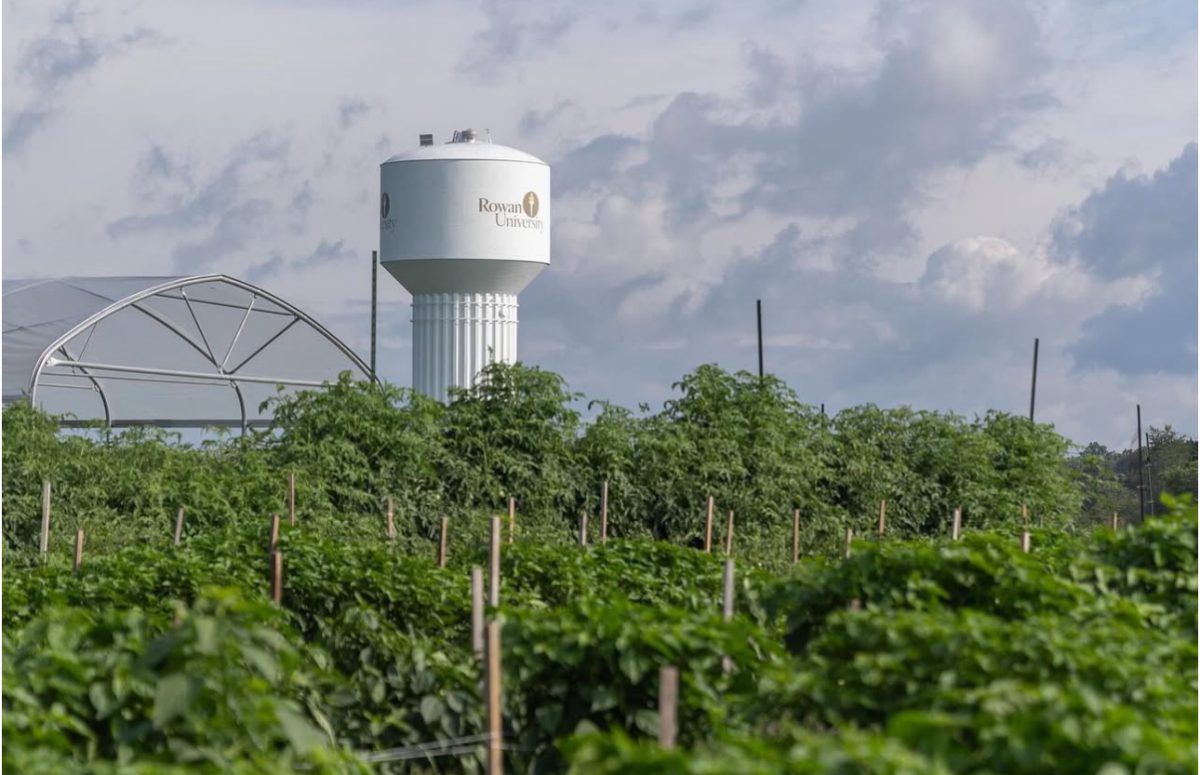This article is part of the “Rowan University of the Future” series, where The Whit highlights areas of growth in Rowan’s long-term plan.
Linda Walczak, the landscape architect for Rowan University, has been at Rowan since 2019, doing her part along with her colleagues in the Division of Facilities, Planning, and Operations in implementing Rowan University’s Stormwater Management and Greenway master plans.
“The Stormwater Management and Landscape Master Plan set the framework for not only stormwater intervention but also its integrated stormwater solutions into other positive aspects for the campus,” Walczak said. “A big piece is slowing down the volume of water that enters the creek. That led to the Greenway Master Plan, which focuses on the stream corridor.”
The creek Walczak refers to is part of the Chestnut Branch, a sub-watershed of the Mantua Creek. It’s a staple of Rowan’s campus; students cross it daily to get from one side of the north campus to the other and walk along it moving east to west. Rowan’s campus runoff flows through the Chestnut Branch, joining tributaries downstream that flow through dozens of communities, draining into the Delaware River southwest of Camden.
“I think we can say that we have made progress with managing stormwater through the use of green infrastructure on campus,” Walczak said. “The intense floods that happened before interventions were put in place have seemingly decreased. The creek still gets flooded, but we have to keep in mind it manages pretty much all of Glassboro’s stormwater; it has a big job to do.”
Rowan University’s main campus is known to have its fair share of flooding. Still, students often miss the environmental impact of these floods on the broader ecosystem, especially considering that Rowan is the steward of the Chestnut Branch.

According to the Delaware Valley Regional Planning Commission (DVRPC), when a development like Rowan University and its surrounding community covers the natural landscape with roads and buildings, rainwater that once would have naturally filtered down into the earth becomes stormwater runoff. The runoff from these impervious surfaces fills watershed streams with high quantities of pollutants and increases the volume of water following rainstorms. This means that Rowan’s contaminants have access to spread throughout the Delaware River basin by way of Mantua Creek. Furthermore, the increased volume of water and its velocity erodes streambanks, leading to the degradation of habitat and function of waterways.
Walczak highlighted completed projects that pertain to the Stormwater Master Plan aimed at limiting Rowan’s contribution of pollutants and reducing runoff volume, like Crossroads at Robinson Green.
Walczak said that the use of permeable paving, including recycled concrete, and the inclusion of bioswales all help manage water more sustainably than when it was just impervious pavement.

“The space is still conducive to pedestrian circulation, but it offers a more pleasant experience for students,” she said. “There is a combination of planted area and open space that can be used in a flexible way. You don’t typically think of a lawn as sustainable because it takes a lot of energy to maintain. Still, it’s part of the balance of college aesthetic and sustainability.”
That balance between sustainability and aesthetics is something Walczak is constantly weighing.
“In my mind, I typically go towards native plants that work in a specific space, mainly if it’s a stormwater management project like our rain gardens or bioswales,” she said. “We are learning that we can have native diversity but have it look groomed. It’s about the balance between a planting being aesthetically acceptable and also serving an ecological function.”
Robinson Green was a finalist in 2017 for the Excellence in Green Stormwater Infrastructure Award from the Sustainable Business Network of Philadelphia. Phase 2 of the project, the adjacent space that includes Wilson Hall’s new outdoor amphitheaters, also utilizes permeable concrete, bioswales, and rain gardens, expanding the focus that went into the first part of the project.
Renovating old areas like Robinson Green to be more sustainable, and making sure new constructions are in the trend of sustainable stormwater management, like The Rohrer College of Business and Discovery Hall, will help. Still, Rowan can’t ignore restoring the wild areas like Rowan Woods or Chestnut Creek.
“Along the creek, for example, the goal is to replace invasive plants with native species over time. We’d like the desirable plants from our region to out-compete the undesirable ones. Managing invasive species is a major piece of landscape management, particularly in wild areas along the creek and Rowan Woods,” said Walczak. “The context is critical; we do have the identity of the campus to keep in mind. There are places that will remain with mowed lawns, azaleas, and big oaks like on the historic south campus. The grounds crew has been fantastic in maintaining these traditional landscapes and I give them credit for being open to tackling the new challenge of the more ecologically-based plantings, which are quite different.”
“There is a long list of invasive flora in Glassboro and the surrounding region. Unfortunately, all places can’t be maintained properly, which act as hubs for invasive species; it’s our job to not contribute to that,” said Walczak. “There is a massive problem, regionally and beyond, with the spotted lanternfly which we have on campus. It’s attracted to a tree which is also invasive, called the tree of heaven.”
The tree of heaven is capable of aggressively reproducing, and if not kept in check, it can dominate ecosystems. It also attracts spotted lanternflies whose excrement attracts a type of mold that will slowly weaken and kill the plant. The spotted lanternfly has recently expanded from Pennsylvania into New Jersey and is considered a threat to native wildlife.
In the past five years, Rowan has diversified the number of plant genera and species, mainly utilizing native plants, which provide habitats for more native insects and other animals. In that timeframe, Rowan planted hundreds of trees, and Walczak estimates that 75% are species that will become large shade trees that provide cooling in the summer and reduce the urban heat island effect.
In addition, a large canopy tree can manage thousands of gallons of stormwater per year and sequester hundreds of pounds of carbon, according to the National Tree Benefit Calculator.
“People will look at things like the rain gardens or demonstration meadow behind Wilson Hall and may not realize they are serving an important purpose. It’s not your typical lawn with trees and annual flowers, but there is beauty in the fact that it contributes to a sustainable campus,” said Walczak. “We want to get the message out so these features are understood and valued. They can support the university’s educational mission.”
Future projects that Walczak highlighted and that are proposed projects from the Greenway Master Plan include a greener Student Center plaza, additional bioswales, the extension of Meditation Walk, outdoor seating areas, and gardens.
Rowan University sits in an important geographical location, with challenges and an opportunity to set the bar high for sustainable stormwater management. Rowan can prove to make the campus beautiful, while at the same time being ecologically sustainable through habitat restoration, carbon sequestration, and pollution reduction. Then the university can truly claim to have a green campus.
For comments/questions about this story, tweet @TheWhitOnline.

























































































































































!["Working with [Dr. Lynch] is always a learning experience for me. She is a treasure,” said Thomas. - Staff Writer / Kacie Scibilia](https://thewhitonline.com/wp-content/uploads/2025/04/choir-1-1200x694.jpg)














































